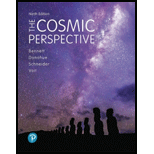
EBK THE COSMIC PERSPECTIVE
9th Edition
ISBN: 9780135161760
Author: Voit
Publisher: VST
expand_more
expand_more
format_list_bulleted
Textbook Question
Chapter 8, Problem 47EAP
Lucky to Be Here? Considering the overall process of solar system formation, do you think formation of a planet like Earth was likely? Could random events in the early history of the solar system have prevented our being here today? What implications do your answers have for the possibility of finding planets with Earth-like conditions around other stars? Defend your opinions.
Expert Solution & Answer
Want to see the full answer?
Check out a sample textbook solution
Students have asked these similar questions
Consider a rubber rod that has been rubbed with fur to give the rod a net negative charge, and a glass rod that has been rubbed with silk to give it a net positive charge. After being charged by contact by the fur and silk...?
a. Both rods have less mass
b. the rubber rod has more mass and the glass rod has less mass
c. both rods have more mass
d. the masses of both rods are unchanged
e. the rubber rod has less mass and the glass rod has mroe mass
8) 9)
10)
11)
12)
13)
14)
15)
Chapter 8 Solutions
EBK THE COSMIC PERSPECTIVE
Ch. 8 - Prob. 1VSCCh. 8 - Prob. 2VSCCh. 8 - Prob. 3VSCCh. 8 -
Briefly describe the four major features of our...Ch. 8 - What is the nebular theory, and why is it widely...Ch. 8 - What do we mean by the solar nebula? What was it...Ch. 8 -
4. Describe the three key processes that led the...Ch. 8 - List the approximate condensation temperature and...Ch. 8 - What was the frost line? Which ingredients...Ch. 8 - Briefly describe the process by which terrestrial...
Ch. 8 - How was the formation of jovian planets similar to...Ch. 8 - What is the solar wind, and what roles did it play...Ch. 8 - How did planet formation lead to the existence of...Ch. 8 - What was the heavy bombardment, and when did it...Ch. 8 - What is the leading hypothesis for the Moon’s...Ch. 8 - Prob. 13EAPCh. 8 - How old is the solar system, and how do we know?Ch. 8 - Surprising Discoveries? Suppose we found a solar...Ch. 8 - Prob. 16EAPCh. 8 - Surprising Discoveries? Suppose we found a solar...Ch. 8 - Prob. 18EAPCh. 8 - Prob. 19EAPCh. 8 - Prob. 20EAPCh. 8 - Prob. 21EAPCh. 8 - Prob. 22EAPCh. 8 - Prob. 23EAPCh. 8 - Prob. 24EAPCh. 8 - Choose the best answer to each of the following....Ch. 8 - Choose the best answer to each of the following....Ch. 8 - Choose the best answer to each of the following....Ch. 8 - Prob. 28EAPCh. 8 - Choose the best answer to each of the following....Ch. 8 - Choose the best answer to each of the following....Ch. 8 - Prob. 31EAPCh. 8 - Choose the best answer to each of the following....Ch. 8 - Choose the best answer to each of the following....Ch. 8 - Choose the best answer to each of the following....Ch. 8 - Explaining the Past. Is it really possible for...Ch. 8 - Prob. 37EAPCh. 8 - Prob. 38EAPCh. 8 - An Early Solar Wind. Suppose the solar wind had...Ch. 8 - Angular Momentum. Suppose our solar nebula had...Ch. 8 - Two Kinds of Planets. The jovian planets differ...Ch. 8 - Prob. 43EAPCh. 8 - Prob. 44EAPCh. 8 - Prob. 45EAPCh. 8 - Prob. 46EAPCh. 8 - Lucky to Be Here? Considering the overall process...Ch. 8 - Radiometric Dating. You are dating rocks by their...Ch. 8 - Lunar Rocks. You are dating Moon rocks based on...Ch. 8 - Carbon-14 Dating. The half-life of carbon-14 is...Ch. 8 - Prob. 51EAPCh. 8 - Icy Earth. How massive would Earth have to have...Ch. 8 - What Are the Odds? The fact that all the planets...Ch. 8 - Spinning Up the Solar Nebula. The orbital speed of...
Knowledge Booster
Learn more about
Need a deep-dive on the concept behind this application? Look no further. Learn more about this topic, physics and related others by exploring similar questions and additional content below.Similar questions
- Mick and Rick are twins born on Earth in the year 2175. Rick grows up to be an Earth-bound robotics technician while Mick becomes an intergalactic astronaut. Mick leaves the Earth on his first space mission in the year 2200 and travels, according to his clock, for 10 years at a speed of 0.75c. Unfortunately, at this point in his journey, the structure of his ship undergoes mechanical breakdown and the ship explodes. How old is Rick when his brother dies?arrow_forwardHi, I have canceled, why did you charge me again?arrow_forwardNo chatgpt pls will upvotearrow_forward
arrow_back_ios
SEE MORE QUESTIONS
arrow_forward_ios
Recommended textbooks for you

 AstronomyPhysicsISBN:9781938168284Author:Andrew Fraknoi; David Morrison; Sidney C. WolffPublisher:OpenStax
AstronomyPhysicsISBN:9781938168284Author:Andrew Fraknoi; David Morrison; Sidney C. WolffPublisher:OpenStax Foundations of Astronomy (MindTap Course List)PhysicsISBN:9781337399920Author:Michael A. Seeds, Dana BackmanPublisher:Cengage Learning
Foundations of Astronomy (MindTap Course List)PhysicsISBN:9781337399920Author:Michael A. Seeds, Dana BackmanPublisher:Cengage Learning
 Stars and Galaxies (MindTap Course List)PhysicsISBN:9781337399944Author:Michael A. SeedsPublisher:Cengage Learning
Stars and Galaxies (MindTap Course List)PhysicsISBN:9781337399944Author:Michael A. SeedsPublisher:Cengage Learning Horizons: Exploring the Universe (MindTap Course ...PhysicsISBN:9781305960961Author:Michael A. Seeds, Dana BackmanPublisher:Cengage Learning
Horizons: Exploring the Universe (MindTap Course ...PhysicsISBN:9781305960961Author:Michael A. Seeds, Dana BackmanPublisher:Cengage Learning


Astronomy
Physics
ISBN:9781938168284
Author:Andrew Fraknoi; David Morrison; Sidney C. Wolff
Publisher:OpenStax

Foundations of Astronomy (MindTap Course List)
Physics
ISBN:9781337399920
Author:Michael A. Seeds, Dana Backman
Publisher:Cengage Learning


Stars and Galaxies (MindTap Course List)
Physics
ISBN:9781337399944
Author:Michael A. Seeds
Publisher:Cengage Learning

Horizons: Exploring the Universe (MindTap Course ...
Physics
ISBN:9781305960961
Author:Michael A. Seeds, Dana Backman
Publisher:Cengage Learning
Kepler's Three Laws Explained; Author: PhysicsHigh;https://www.youtube.com/watch?v=kyR6EO_RMKE;License: Standard YouTube License, CC-BY